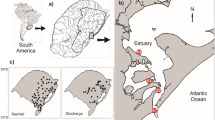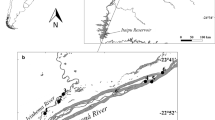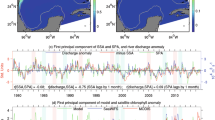Abstract
The ENSO (El Niño-Southern Oscillation) phenomenon affects, through climate teleconnections, hydrometric variables of water bodies worldwide, influencing biota communities. The aim of this work is to analyze ENSO effects on water discharge, water level, cyanobacterial blooms and, consequently, on the reproduction of migratory fishes with high-frequency monitoring of ichthyoplankton data from Salto Grande, a large South American reservoir. Two highest peaks of ichthyoplankton density were observed; the first one (2015–2016) occurred during a very strong El Niño event, while the second one (2019–2020) was preceded by weak El Niño events that lasted 18 months. These results suggest that ichthyoplankton abundance may be affected by the intensity and temporal extent of the episodes. In contrast, mean fish larval and egg densities were reduced by 65% and 85%, respectively during La Niña periods. Cross-correlation function (CCF) analysis indicates that water discharge, water level, and ichthyoplankton abundance were positively related to the Oceanic Niño Index, while cyanobacteria showed an inverse relationship. Cyanobacterial density increased by 574% during La Niña compared with El Niño events. Based on an uninterrupted monitoring of ichthyoplankton over 11 years, it seems reasonable to consider ENSO as a predictive tool for the intensity of reproductive activity of migratory fishes.








Similar content being viewed by others
References
Abtew, W. & A. Melesse, 2014. Climate Teleconnections and Water Management. In Melesse, A. M., W. Abtew & S. G. Setegn (eds), Nile River Basin Ecohydrological Challenges, Climate Change and Hydropolitics Springer, Heidelberg NewYork: 685–706.
Agostinho, A. A., L. C. Gomes, H. I. Suzuki & H. F. Júlio Jr., 2004. Migratory fishes of the Upper Paraná. In Carolsfield, J., B. Harvey, C. Ross & A. Baer (eds), Migratory Fish of South America: Biology, Fisheries and Conservation Status River Basin World Bank, Victoria, Canada: 19–98.
Akash, S., P. Shah, M. Shafeeque, A. S. Pooja, P. U. Zacharia, J. K. Ajith, V. Bharti, T. V. Sathianandan & G. George, 2021. Observed links between coastal ocean processes and Indian Oil Sardine (Sardinella longiceps) fishery along the southwest coast of India. Regional Studies in Marine Science 46: 101850.
Alves, J. C., G. F. Andreotti, A. A. Agostinho & L. Gomes, 2021. Effects of the El Niño Southern Oscillation (ENSO) on fish assemblages in a Neotropical floodplain. Hydrobiologia 848: 1811–1823.
Amarasekera, K. N., R. F. Lee, E. R. Williams & E. A. B. Eltahir, 1997. ENSO and the natural variability in the flow of tropical rivers. Journal of Hydrology 200: 24–39.
Antico, A., R. O. Aguiar & M. L. Amsler, 2018. Hydrometric data rescue in the Paraná River Basin. Water Resources Research 54: 1368–1381.
Bartram, J., 1999. The World Health Organization in Europe and its role in water and health. Environmentalist 19: 17–22.
Baumgartner, G., K. Nakatani, L. Gomes, A. Bialetzki & P. Sanches, 2004. Identification of spawning sites and natural nurseries of fishes in the upper Paraná River, Brazil. Environmental Biology of Fishes 71: 115–125.
Belarmino, E., M. F. de Nóbrega, A. M. Grimm, M. da Silva Copertino, J. P. Vieira & A. M. Garcia, 2021. Long-term trends in the abundance of an estuarine fish and relationships with El Niño climatic impacts and seagrass meadows reduction. Estuarine, Coastal and Shelf Science 261: 107565.
Berón, L. E., 1990. Features of the limnological behavior of Salto Grande’s reservoir (Argentina- Uruguay). Ecological Modelling 52: 87–102.
Boltovskoy, D., N. Correa, F. Bordet, V. Leites & D. Cataldo, 2013. Toxic Microcystis (cyanobacteria) inhibit recruitment of the bloom-enhancing invasive bivalve Limnoperna fortunei. Freshwater Biology 58: 1968–1981.
Bonetto, A. A., M. Cannon Veron & D. Roldán, 1981. Nuevos aportes al conocimiento de las migraciones de peces en el río Paraná. Ecosur 8: 29–40.
Bordet, F., M. S. Fontanarrosa & I. O’Farrell, 2017. Influence of light and mixing regime on bloom-forming phytoplankton in a subtropical reservoir. River Research and Applications 33: 1315–1326.
Camacho Guerreiro, A. I., S. A. Amadio, N. N. Fabré & V. da Silva Batista, 2021. Exploring the effect of strong hydrological droughts and floods on populational parameters of Semaprochilodus insignis (Actinopterygii: Prochilodontidae) from the Central Amazonia. Environment, Development and Sustainability 23: 3338–3348.
Camilloni, I. & V. Barros, 2000. The Paraná River response to El Niño 1982–83 and 1997–98 events. Journal of Hydrometeorology 1: 412–430.
Carolsfield, J., B. Harvey, C. Ross & A. Baer, 2004. Migratory Fish of South America: Biology, Fisheries and Conservation Status, World Bank, Victoria:
Cataldo, D., 2015. Trophic relationships of Limnoperna fortunei with adult fishes. In Boltovskoy, D. (ed), Limnoperna fortunei: The Ecology, Distribution and Control of a Swiftly Spreading Invasive Fouling Mussel Springer, Cham: 231–248.
Cataldo, D., F. Gattás, V. Leites, F. Bordet & E. Paolucci, 2020. Impact of a hydroelectric power plant on migratory fishes in the Uruguay River. River Research and Applications 36: 1598–1611.
Chalar, G., 2006. Eutrophication dynamics on different temporal scales: Salto Grande Reservoir (Argentina-Uruguay). In Tundisi, J. G., T. Matsumura-Tundisi & T. Sidagis (eds), Eutrophication in South America: Causes, Consequences and Technologies for Management and Control International Institute of Ecology, Sao Carlos: 87–101.
Chalar, G., L. De León, E. Brugnoli, J. Clemente & M. Paradiso, 2002. Antecedentes y nuevos aportes al conocimiento de la estructura y dinámica del Embalse Salto Grande El agua en Sudamérica: de la Limnología a la Gestión en Sudamérica. In Fernández-Cirelli, A. C. G. (ed), Aprovechamiento y Gestión de los Recursos Hídricos Editorial Eudeba, Buenos Aires: 123–142.
Chatfield, C. & H. **ng, 2019. The Analysis of Time Series: An Introduction with R. Chapman and Hall, CRC Press, Boca Raton: 1–414.
Cheal, A. J., S. Delean, H. Sweatman & A. A. Thompson, 2007. Spatial synchrony in coral reef fish populations and the influence of climate. Ecology 88: 158–169.
Chorus, I. & J. Bartram, 1999. Toxic Cyanobacteria in Water: A Guide to Their Public Health Consequences Monitoring and Management, CRC Press, London:, 1–432.
Colombo, J. C., C. N. Skorupka, C. Bilos, L. Tatone, N. Cappelletti, M. Carolina Migoya, M. Astoviza & E. Speranza, 2015. Seasonal and inter-annual variability of water quality in the Uruguay River, Argentina. Hydrological Sciences Journal 60: 1155–1163.
Dettinger, M. D. & H. F. Diaz, 2000. Global characteristics of stream flow seasonality and variability. Journal of Hydrometeorology 1: 289–310.
Dettinger, M., D. Cayan, G. McCabe & J. Marengo, 2000. Multiscale streamflow variability associated with El Niño/Southern Oscillation. In Diaz, H. F. & V. Markgraf (eds), El Niño and the Southern Oscillation-Multiscale Variability and Global and Regional Impacts University Press, Cambridge: 113–146.
Di Rienzo, J. A., F. Casanoves, G. Balzarini, L. Gonzalez, M. Tablada & C. W. Robledo, 2017. Grupo InfoStat. FCA, Universidad Nacional de Córdoba, Argentina. http://www.infostat.com.ar.
Engle, R. & C. Granger, 1987. Cointegration and error-correction: Representation, estimation and testing. Econometrica 55: 251–276.
Espinach Ros, A., S. Sverlij, F. Amestoy & M. Spinetti, 1998. Migration pattern of the sábalo Prochilodus lineatus (Pisces, Prochilodontidae) tagged in the lower Uruguay River. Verhandlungen Des Internationalen Verein Limnologie 26: 2234–2236.
Fisher, J., W. Peterson & R. Rykaczewski, 2015. The impact of El Niño events on the pelagic food chain in the northern California Current. Global Change Biology 21(12): 4401–4414.
Fuentes, C. M. & A. Espinach Ros, 1998. Variación de la actividad reproductiva del sábalo, Prochilodus lineatus (Valenciennes, 1847), estimada por el flujo de larvas en el rıo Paraná Inferior. Natura Neotropicalis 29: 25–32.
Garcia, C. Z. & C. B. R. Martinez, 2012. Biochemical and genetic alterations in the freshwater neotropical fish Prochilodus lineatus after acute exposure to Microcystis aeruginosa. Neotropical Ichthyology 10: 613–622.
Garcia, A. M., J. P. Vieira, K. O. Winemiller & A. M. Grimm, 2004. Comparison of 1982–1983 and 1997–1998 El Niño effects on the shallow-water fish assemblage of the Patos Lagoon Estuary (Brazil). Estuaries 27: 905–914.
Giannuzzi, L., D. Sedan, R. Echenique, & D. Andrinolo, 2011. An acute case of intoxication with cyanobacteria and cyanotoxins in recreational water in salto grande dam argentina. Marine Drugs 9(11): 2164–2175. https://doi.org/10.3390/md9112164
Glynn, P. W., A. B. Mones, G. P. Podestá, A. Colbert & M. W. Colgan, 2017. El Niño-Southern Oscillation: Effects on eastern pacific coral reefs and associated viota. In Glynn, P. W., D. P. Manzello & I. C. Enochs (eds), Coral Reefs of the Eastern Tropical Pacific: Persistence and Loss in a Dynamic Environment Springer, Dordrecht: 251–290.
Granger, C. W. J. & P. Newbold, 1974. Spurious regressions in econometrics. Journal of Econometrics 2: 111–120.
Huang, B., P. W. Thorne, V. F. Banzon, T. Boyer, G. Chepurin, J. H. Lawrimore, M. J. Menne, T. M. Smith, R. S. Vose & H.-M. Zhang, 2017. Extended reconstructed sea surface temperature, Version 5 (ERSSTv5): Upgrades, Validations, and Intercomparisons. Journal of Climate 30: 8179–8205.
Kiladis, G. N. & H. F. Diaz, 1989. Global climatic anomalies associated with extremes in the Southern Oscillation. Journal of Climate 2: 1069–1090.
Lehodey, P., M. Bertignac, J. Hampton, A. Lewis & J. Picaut, 1997. El Niño Southern Oscillation and tuna in the western Pacific. Nature 389: 715–718.
Lopes, J. M., C. B. Mascarenhas, A. Alves & P. P. Santos Pompeu, 2021. Dazed and confused: behavioural constraints impose major challenges to fish passage in the neotropics. Aquatic Conservation: Marine and Freshwater Ecosystems 31(2): 3403–3415.
Mechoso, C. & G. Pérez-Iribarren, 1992. Streamflow in southeastern South America and the southern oscillation. Journal of Climate 5: 1535–1536.
Menni, R. C., 2004. Peces y ambientes en la Argentina continental., vol 5. Monografías del Museo Argentino de Ciencias Naturales (MACN), Buenos Aires.
Mitsoura, A., I. Kagalou, N. Papaioannou, P. Berillis, E. Mente & T. Papadimitriou, 2013. The presence of microcystins in fish Cyprinus carpio tissues: a histopathological study. International Aquatic Research 5: 8.
Mol, J. H., D. Resida, J. S. Ramlal & C. R. Becker, 2000. Effects of El Niño-related drought on freshwater and brackish-water fishes in Suriname, South America. Environmental Biology of Fishes 59: 429–440.
Nakatani, K., A. A. Agostinho, G. Baumgartner, A. Bialetzki, P. V. Sanches, M. C. Makrakis & C. S. Pavanelli, 2001. Ovos e larvas de peixes de água doce: desenvolvimento e manual de identificação. Eduem, Maringá.
NOAA, 2021. Climate Prediction Center/NCEP. https://origin.cpc.ncep.noaa.gov/products/analysis_monitoring/ensostuff/ONI_v5.php. Accessed 3 May 2021.
O’Farrell, I., F. Bordet & G. Chaparro, 2012. Bloom forming cyanobacterial complexes co-occurring in a subtropical large reservoir: validation of dominant eco-strategies. Hydrobiologia 698: 175–190.
Paolucci, E. M., 2002. Actividad reproductiva del sábalo Prochilodus lineatus (Valenciennes, 1847) y otras especies de interés comercial y deportivo en el río Uruguay Inferior, estimada por la abundancia de estadios larvales en la deriva. Dissertation, Buenos Aires University.
Paolucci, E. M. & E. V. Thuesen, 2015. Trophic relationships of Limnoperna fortunei with larval fishes. In Boltovskoy, D. (ed), Limnoperna fortunei: The Ecology, Distribution and Control of a Swiftly Spreading Invasive Fouling Mussel Springer, Cham: 211–229. Invading Nature—Springer Series in Invasion Ecology.
Paolucci, E. M., D. H. Cataldo, C. M. Fuentes & D. Boltovskoy, 2007. Larvae of the invasive species Limnoperna fortunei (Bivalvia) in the diet of fish larvae in the Paraná River, Argentina. Hydrobiologia 589: 219–233.
Paolucci, E. M., V. Leites, D. H. Cataldo & D. Boltovskoy, 2017. Veligers of the invasive bivalve Limnoperna fortunei in the diet of indigenous fish larvae in a eutrophic subtropical reservoir. Austral Ecology 42: 759–771.
Pelicice, F. M., P. S. Pompeu & A. A. Agostinho, 2015. Large reservoirs as ecological barriers to downstream movements of Neotropical migratory fish. Fish and Fisheries 16(4): 697–715.
Pisciottano, G., A. Díaz, G. Cazess & C. Mechoso, 1994. El Niño-Southern oscillation impact on rainfall in Uruguay. Journal of Climate 7: 1286–1304.
Polis, G. A., S. D. Hurd, C. T. Jackson & F. S. Piñero, 1997. El Niño effects on the dynamics and control of an island ecosystem in the Gulf of California. Ecology 78: 1884–1897.
Ponton, D., 2001. ENSO and the hydrology of the Sinnamary River (French Guiana) during the rainy season: Will future El Niño events increase the impact of the Petit Saut dam on downstream fish communities? Archiv Für Hydrobiologie 152: 451–468.
Possamai, B., J. P. Vieira, A. M. Grimm & A. M. Garcia, 2018. Temporal variability (1997–2015) of trophic fish guilds and its relationships with El Niño events in a subtropical estuary. Estuarine, Coastal and Shelf Science 202: 145–154.
Probst, W. N., V. Stelzenmüller & H. O. Fock, 2012. Using cross-correlations to assess the relationship between time-lagged pressure and state indicators: an exemplary analysis of North Sea fish population indicators. ICES Journal of Marine Science 69: 670–681.
Reynolds, C. S. & G. H. M. Jaworski, 1978. Enumeration of natural Microcystis populations. British Phycological Journal 13: 269–277.
Saltzmann, C., 1993 Informe final de beca de Perfeccionamiento. In: Comisión de Investigación Científica de la Provincia de Buenos Aires, La Plata, Argentina.
Sánchez-Velasco, L., C. Avalos-García, M. Rentería-Cano & B. Shirasago, 2004. Fish larvae abundance and distribution in the central Gulf of California during strong environmental changes (1997–1998 El Niño and 1998–1999 La Niña). Deep Sea Research Part II: Topical Studies in Oceanography 51: 711–722.
Silva, F. N., D. Vega-Oliveros, X. Yan, A. Flammini, F. Menczer, F. Radicchi, B. Kravitz & S. Fortunato, 2020. Detecting climate teleconnections with Granger causality. Atmospheric and Oceanic Physics. https://doi.org/10.1029/2021GL094707.
Smolders, A. J. P., G. Van Der Velde & J. G. M. Roelofs, 2000. El Nino caused collapse of the sabalo fishery (Prochilodus lineatus, Pisces: Prochilodontidae) in a South American river. Naturwissenschaften 87: 30–32.
Snyder, D. E., 1983. Fish eggs and larvae. In Nielsen, L. & D. Johnson (eds), Fisheries Techniques American Fisheries Society, Bethesda: 165–197.
Sullivan, R. M. & J. Hileman, 2021. Time series modeling and forecasting of a highly regulated riverine system: implications for fisheries management. California Fish and Wildlife 106: 221–259.
Sverlij, S. B., A. Espinach Ros & G. Orti, 1993. Sinopsis de los datos biológicos y pesqueros del sábalo Prochilodus lineatus (Valenciennes, 1847), No. 154, 64 pp. In: FAO (ed.), FAO Sinopsis sobre la Pesca. FAO, Roma: 64 pp.
Swales, S., A. W. Storey, I. D. Roderick & B. S. Figa, 1999. Fishes of floodplain habitats of the Fly River system, Papua New Guinea, and changes associated with El Niño droughts and algal blooms. Environmental Biology of Fishes 54: 389–404.
Trenberth, K. E. & T. J. Hoar, 1996. The 1990–1995 El Niño-Southern oscillation event: longest on tecord. Geophysical Research Letters 23: 57–60.
Venrick, E. L., 1978. How many cells to count? In Sournia, A. (ed), Phytoplankton Manual UNESCO Press, Paris: 167–168.
Welcomme, R., 1979. Fisheries Ecology of Floodplain Rivers, Longman, London:
Zaniboni Filho, E. & U. H. Schulz, 2004. Migratory fishes of the Uruguay River. In Carolsfield, J., B. Harvey, C. Ross & A. Baer (eds), Migratory fishes of South America: Biology, Fisheries, and Conservation Status World Fisheries Trust/World Bank/IDRC, Washington DC: 157–194.
Acknowledgements
The author thanks the Environmental Department of the Joint Technical Commission of Salto Grande (Argentina–Uruguay) for field assistance. This work was supported by STAN CONICET-CTMSG (ST636 2009-2020).
Author information
Authors and Affiliations
Contributions
Conceived and designed the investigation: DC, EP Performed field and/or laboratory work: DC, EP, VL, FB. Analyzed the data: DC, EP. Wrote and revised the paper: DC, EP, VL, FB.
Corresponding author
Ethics declarations
Conflict of interest:
The authors declare that they have no conflict of interest.
Research involving human and animal rights
In our research no laboratory experiments with animals were performed. The larval fish collected during the field work was immediately fixed to minimize the suffering of the animals and meet generally acceptable animal ethical standards. Although it involved the sacrifice of early stages of fish development, it does not put biological diversity at risk. The results of the research allow obtaining valuable information on the reproduction of migratory fish to be used in the management and maintenance of ichthyofauna.
Additional information
Handling editor: Fernando M. Pelicice
Publisher's Note
Springer Nature remains neutral with regard to jurisdictional claims in published maps and institutional affiliations.
Rights and permissions
About this article
Cite this article
Cataldo, D., Leites, V., Bordet, F. et al. Effects of El Niño-Southern Oscillation (ENSO) on the reproduction of migratory fishes in a large South American reservoir. Hydrobiologia 849, 3259–3274 (2022). https://doi.org/10.1007/s10750-022-04941-6
Received:
Revised:
Accepted:
Published:
Issue Date:
DOI: https://doi.org/10.1007/s10750-022-04941-6




